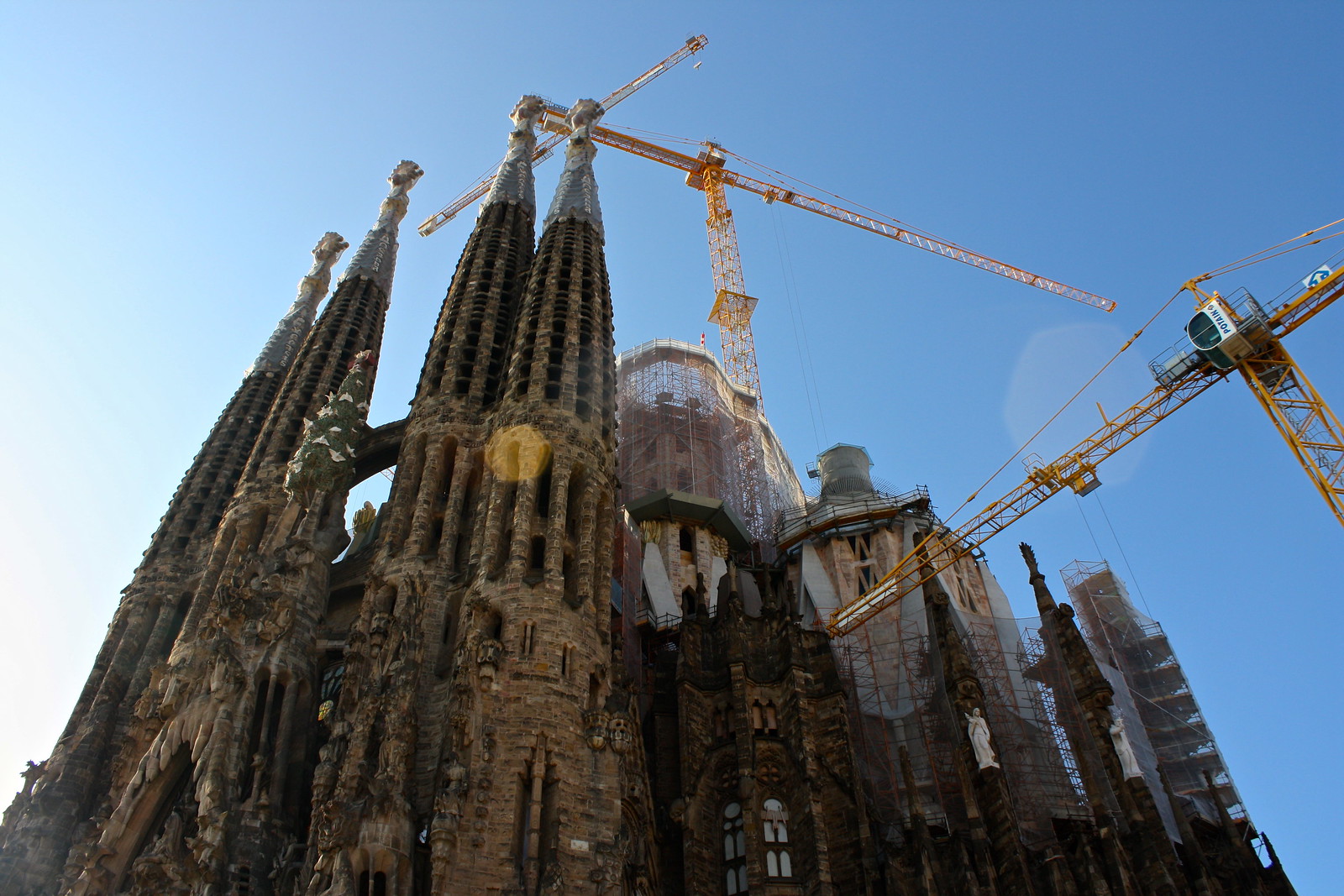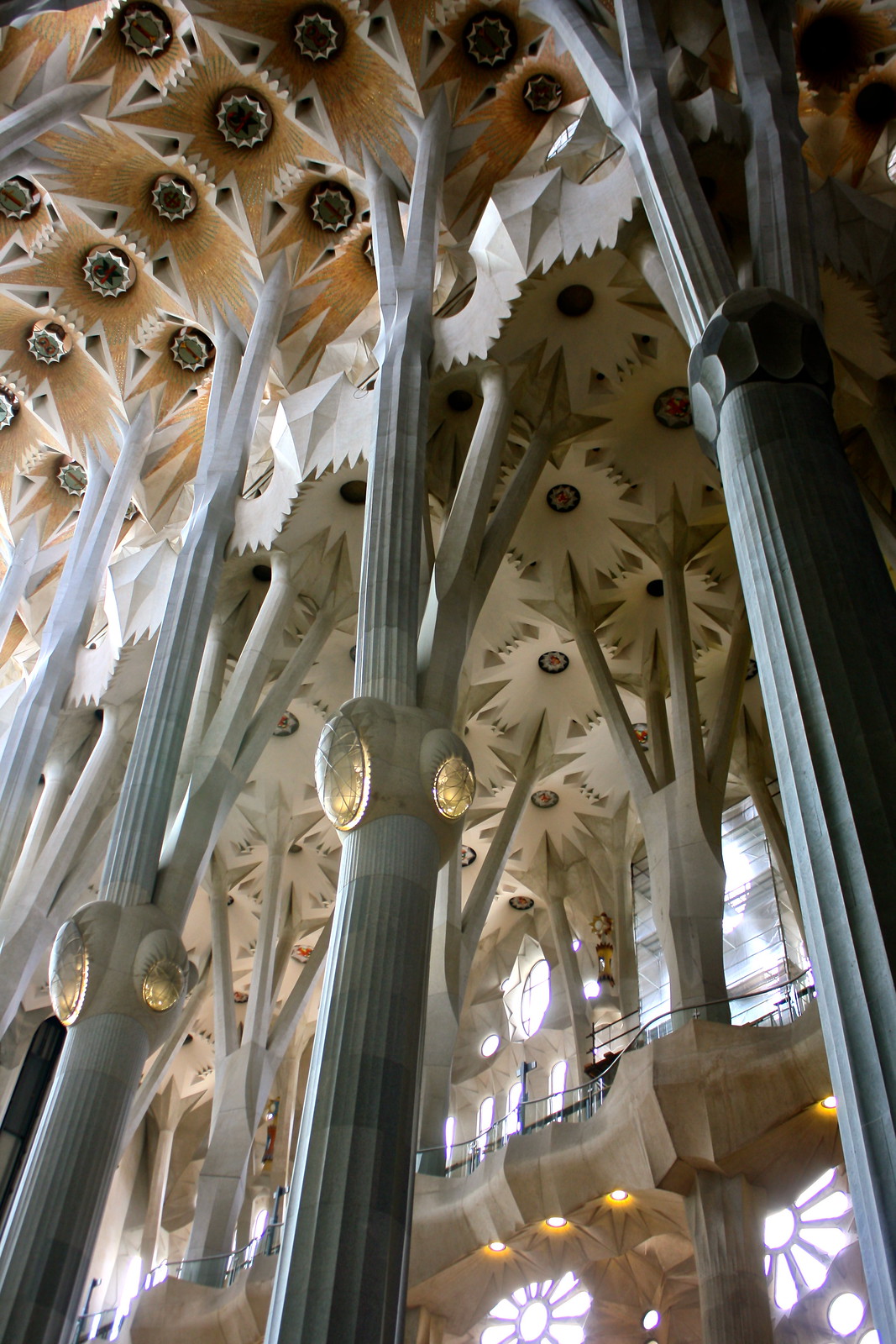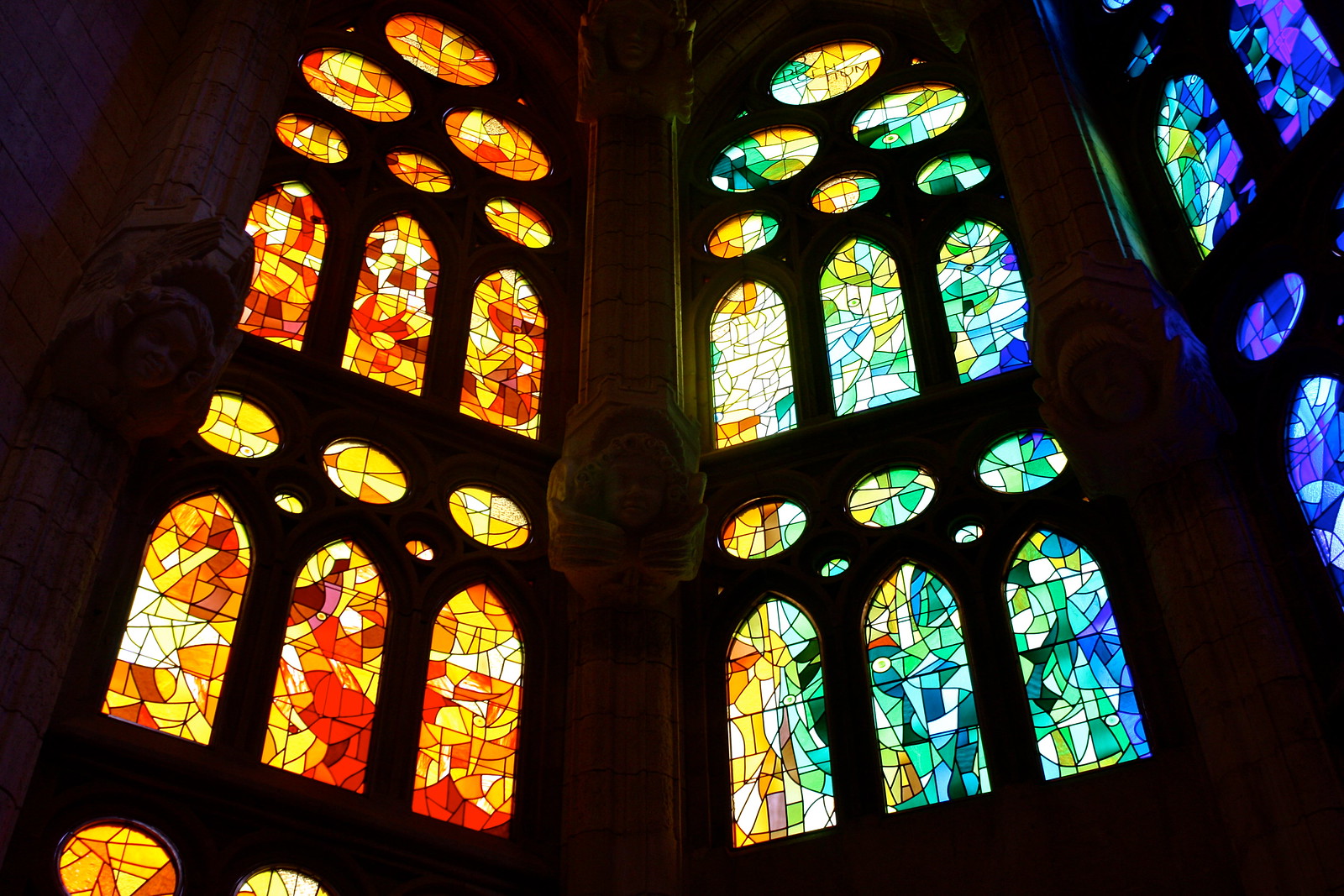Gaudí Week #1: Sagrada Família in Barcelona, Spain
This week on the blog, I’m celebrating works by the famous turn-of-the-century Catalan architect Antoni Gaudí, who designed everything from churches to mansions to public parks. This post is the first in a seven-part series; check out the introduction here!
Unquestionably Gaudí’s masterpiece, the Sagrada Família is a Catholic basilica that takes up a whole city block in Barcelona’s Eixample district, the new part of town where the streets run on a vast, grand grid. The church is arguably Spain’s most significant and beautiful piece of architecture (vying with the Alhambra, a Moorish palatial complex in Granada to the south). And it is without a doubt an iconic symbol of Barcelona, much as the Golden Gate Bridge represents San Francisco or the Cristo Redentor statue does for Rio de Janeiro.
Many people assume the Sagrada Família is the city’s cathedral, but it’s actually a minor basilica. Barcelona’s Gothic-style cathedral can be found in the old town, where it has stood for the past half-dozen centuries. (Side-note: a cathedral is home to a bishop or archbishop, referring to the cathedra or seat that represents their authority.) The Sagrada Família is, rather, a basilica, a significant and important church that has been granted special privileges. Pope Benedict XVI gave the church said status when he consecrated it in 2010. The church is dedicated to the Sagrada Família, Catalan for the “Holy Family” of Joseph, Mary, and Jesus.
Although in its fourth year as a fully-functioning church (now that the naves have been completely roofed over), the Sagrada Família is still a work in progress. I think this makes visiting it now, before it’s finished in the middle of the century, so interesting, because it gives us a feel for what the Middle Ages would have been like when all the great Gothic cathedrals were erected. It often took centuries for such monumental works to be completed, and the Sagrada Família will be no different. I would love to come back to Barcelona in a few decades when all the bell towers have been raised; it’s going to be unbelievably beautiful.
Construction began on the church in 1882 and Gaudí became its architect the following year. Initially, he had planned to do a Gothic Revival-style church (see, for example, the crypt and the apse) but a few sketches later and the church had been transformed into something never before seen in Western architecture. He went all-in with his avant-garde architectural ideas, making the stonework on the Nativity Façade look like oozing slime and the main pillars inside the church branch out like trees. He also took advantage of geometric calculations with hyperboloids (no idea what those are!) and, with his fractal-like columns, was able to construct a massive, soaring, weight-bearing space without the use of Gothic flying buttresses.
The exterior of the church is alive with a myriad of statues, sculptures, and statements. On the Passion Façade, Star Wars stormtrooper-looking Roman soldiers lead a chiseled Jesus to Calvary, four root-like pillars reach down at dramatic angles, and the entrance door is covered in selections from the gospels in Catalan. Some phrases on the door are illuminated in gold/bronze, like Jesus de Natzaret, Rei dels Jueus (“Jesus of Nazareth, King of the Jews”) and i què és la veritat? (“and what is truth?” —Pontius Pilate). Some of the lower pointy towers are capped with what looks like raspberries and Skittles, and the taller bell towers are inscribed with words like Oració (“prayer”) and Credo (“I believe”).
The interior is, excuse the cliché, a riot of colors—you can find bright reds, blues, and greens in the many stained glass windows as well as in the bug-eye looking pillar capitals that represent the four Evangelists. Light pours in from the western wall, the many large windows, and skylights above. And the ceiling supported by the branching pillars makes you feel like you’re inside a pink springtime forest, or beneath a sky of exploding fireworks, or in a fantasy undersea world of coral, sea anemones, and kelp.
Come to get the chills, to appreciate a revolutionary architecture, to pray. It’s one of the coolest places you can visit in Barcelona, or anywhere in Spain.
Please tell me you made a stop here if you’ve ever been to Barcelona…right, right?!? Comment below!
 |
| The Sagrada Família’s Nativity Façade |
Unquestionably Gaudí’s masterpiece, the Sagrada Família is a Catholic basilica that takes up a whole city block in Barcelona’s Eixample district, the new part of town where the streets run on a vast, grand grid. The church is arguably Spain’s most significant and beautiful piece of architecture (vying with the Alhambra, a Moorish palatial complex in Granada to the south). And it is without a doubt an iconic symbol of Barcelona, much as the Golden Gate Bridge represents San Francisco or the Cristo Redentor statue does for Rio de Janeiro.
Many people assume the Sagrada Família is the city’s cathedral, but it’s actually a minor basilica. Barcelona’s Gothic-style cathedral can be found in the old town, where it has stood for the past half-dozen centuries. (Side-note: a cathedral is home to a bishop or archbishop, referring to the cathedra or seat that represents their authority.) The Sagrada Família is, rather, a basilica, a significant and important church that has been granted special privileges. Pope Benedict XVI gave the church said status when he consecrated it in 2010. The church is dedicated to the Sagrada Família, Catalan for the “Holy Family” of Joseph, Mary, and Jesus.
 |
| Nave of the Sagrada Família |
Although in its fourth year as a fully-functioning church (now that the naves have been completely roofed over), the Sagrada Família is still a work in progress. I think this makes visiting it now, before it’s finished in the middle of the century, so interesting, because it gives us a feel for what the Middle Ages would have been like when all the great Gothic cathedrals were erected. It often took centuries for such monumental works to be completed, and the Sagrada Família will be no different. I would love to come back to Barcelona in a few decades when all the bell towers have been raised; it’s going to be unbelievably beautiful.
Construction began on the church in 1882 and Gaudí became its architect the following year. Initially, he had planned to do a Gothic Revival-style church (see, for example, the crypt and the apse) but a few sketches later and the church had been transformed into something never before seen in Western architecture. He went all-in with his avant-garde architectural ideas, making the stonework on the Nativity Façade look like oozing slime and the main pillars inside the church branch out like trees. He also took advantage of geometric calculations with hyperboloids (no idea what those are!) and, with his fractal-like columns, was able to construct a massive, soaring, weight-bearing space without the use of Gothic flying buttresses.
 |
| Tower caps that make me hungry |
The exterior of the church is alive with a myriad of statues, sculptures, and statements. On the Passion Façade, Star Wars stormtrooper-looking Roman soldiers lead a chiseled Jesus to Calvary, four root-like pillars reach down at dramatic angles, and the entrance door is covered in selections from the gospels in Catalan. Some phrases on the door are illuminated in gold/bronze, like Jesus de Natzaret, Rei dels Jueus (“Jesus of Nazareth, King of the Jews”) and i què és la veritat? (“and what is truth?” —Pontius Pilate). Some of the lower pointy towers are capped with what looks like raspberries and Skittles, and the taller bell towers are inscribed with words like Oració (“prayer”) and Credo (“I believe”).
The interior is, excuse the cliché, a riot of colors—you can find bright reds, blues, and greens in the many stained glass windows as well as in the bug-eye looking pillar capitals that represent the four Evangelists. Light pours in from the western wall, the many large windows, and skylights above. And the ceiling supported by the branching pillars makes you feel like you’re inside a pink springtime forest, or beneath a sky of exploding fireworks, or in a fantasy undersea world of coral, sea anemones, and kelp.
 |
| Stained glass windows |
Come to get the chills, to appreciate a revolutionary architecture, to pray. It’s one of the coolest places you can visit in Barcelona, or anywhere in Spain.
How to get there
The Sagrada Família can be found at the block formed by Provença, Marina, Mallorca, and Sardenya streets in the Eixample district. Take the L5 (blue line) on the Metro and get off at the Sagrada Família stop.Please tell me you made a stop here if you’ve ever been to Barcelona…right, right?!? Comment below!